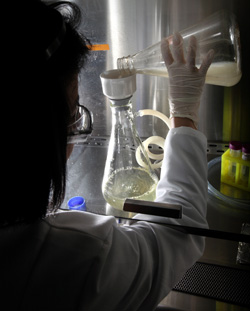LIVERMORE, Calif.— Researchers at Sandia National Laboratories will use their expertise in protein expression, enzyme engineering and high-throughput assays as part of a multiproject, $34 million effort by the Advanced Research Projects Agency-Energy (ARPA-E) aimed at developing advanced biocatalyst technologies that can convert natural gas to liquid fuel for transportation.
The ARPA-E program is Reducing Emissions using Methanotrophic Organisms for Transportation Energy, REMOTE, and involves 15 different projects. Sandia is a part of a two-year award led by MOgene Green Chemicals, a wholly owned subsidiary of St. Louis-based MOgene, LC, and will work toward sunlight-assisted conversion of methane to butanol.

The broad goal is to have another source of energy in the U.S. that doesn’t have to be imported and could lead to lower carbon monoxide emissions than conventional fossil fuels.
Methanotrophs are microbes that can metabolize methane. Sandia’s Blake Simmons, manager of the labs’ biofuels and biomaterial science and technology group, calls this microbe the “poster child” of organisms that are capable of metabolizing and converting methane. The goal of the project is to engineer pathways from these organisms into another microbial host that can generate butanol. Butanol can be used as a fuel in an internal combustion engine and, along with ethanol, has long been considered one of the best biofuel options for transportation energy.
“The need for hydrocarbons that are nonpetroleum in origin is still growing, including applications such as aviation and diesel engines,” said Simmons. “But in its natural state, you’re not going to readily burn natural gas in those types of engines, and the same goes for some combustion engines.” Natural gas, he explains, requires a special modification to be used effectively as a liquid fuel in vehicles, much like biomass needs to be converted before it can be used as a drop-in fuel.
“With biomass, we are essentially taking something that exists in nature and converting it into a low-cost, low-carbon, domestically-sourced fuel. With this project, we’re using natural gas as the input rather than biomass,” said Simmons. Natural gas extracted from the ground is not renewable, he pointed out, but it is playing an increasingly important role for the Department of Energy and the nation’s energy supply.
Simmons said MOgene brings a great deal of organism expertise to the table, while Sandia offers enzyme engineering and other capabilities.
Improving upon nature to convert gaseous feedstocks
Using organisms to convert natural gas into liquid transportation fuels isn’t a new objective for the research community, Simmons said. “There have been plenty of investigations into this in the past, since there are plenty of organisms in nature that thrive and survive and multiply off of natural gas metabolism. The problem, though, is that they exist in unique, tailored environments and are typically very slow at what they do,” he said. ARPA-E’s projects, he said, are hoping to improve upon “what nature has given us” and develop new, more efficient pathways to speed up the process and convert gaseous feedstocks at a pace and scale that is commercially viable. Currently, there are no proven biological methods for converting gaseous inputs such as natural gas into butanol.
“What we and others are doing is looking at the core metabolism of these microbes,” Simmons said. “Then, we can either engineer it to make it faster in native organisms or we can take the metabolism out of those organisms and put it in something more industrially relevant.”
Though the research community has wrestled with this problem before without much success, Simmons thinks Sandia is up to the task based on the labs’ work with membrane proteins and various tools developed over the years.
“Time and time again, through internal investments and our work at the Joint BioEnergy Institute (JBEI), Sandia has proven its ability to express proteins that are difficult to express,” Simmons said. The labs also possess engineering and modeling tools and the ability to build high-throughput custom enzymes assays, significant proficiencies that can lead to better performance in enzymes. Few research organizations, said Simmons, offer that package of technical capabilities to tackle a problem like this one.
Simmons acknowledges that meeting the objectives will not be a simple endeavor.
“People have been trying to express this class of enzymes for a couple of decades,” he says, “so this definitely won’t be a slam dunk. It’s been a confounding scientific challenge for the research community, and this is a notoriously difficult class of proteins. But we have the collective experience and capabilities at Sandia to figure it out.”